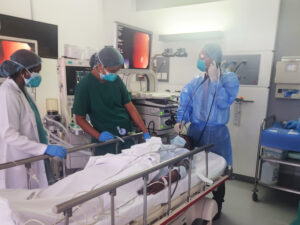Bronchoscopic Lung Biopsy
 Bronchoscopic lung biopsy is a minimally invasive procedure that involves obtaining a tissue sample from the lung for diagnostic purposes. It is performed using a bronchoscope, a flexible tube with a light and camera at its tip that allows visualization of the airways and collection of tissue samples.
Bronchoscopic lung biopsy is a minimally invasive procedure that involves obtaining a tissue sample from the lung for diagnostic purposes. It is performed using a bronchoscope, a flexible tube with a light and camera at its tip that allows visualization of the airways and collection of tissue samples.
Here's an overview of the process of bronchoscopic lung biopsy:
1. Preparation: Before the procedure, the patient may receive local anesthesia to numb the throat and reduce discomfort. Conscious sedation or general anesthesia may also be used to help the patient relax or perform more extensive interventions.
2. Insertion of the bronchoscope: The bronchoscope is inserted through the nose or mouth and carefully advanced through the airways, passing through the vocal cords into the trachea and bronchial tree.
3. Visualization and target identification: The bronchoscopist uses the camera on the bronchoscope to visualize the airways and identify the target site for biopsy. This may include abnormal areas, suspicious lesions, or regions of interest seen during the examination.
4. Biopsy: Once the target area is identified, various biopsy techniques can be employed. These include forceps biopsy, where small tissue samples are obtained using specialized instruments passed through the bronchoscope. Alternatively, needle biopsy or transbronchial needle aspiration (TBNA) may be performed, in which a fine needle is guided through the bronchoscope to collect samples from lymph nodes or masses adjacent to the airways.
5. Specimen collection and processing: The collected tissue samples are sent to a pathology laboratory, where they are processed, stained, and examined under a microscope by a pathologist. The pathologist analyzes the samples to determine the nature of the tissue, identify any abnormal cells or structures, and establish a diagnosis.
6. Post-procedure care: After the procedure, the patient is monitored for any immediate complications, such as bleeding, pneumothorax (collapsed lung), or respiratory distress. The patient may experience a sore throat, cough, or mild bleeding, which typically resolve within a short time. Recovery time is usually minimal, and patients can often resume normal activities shortly after the procedure.
Bronchoscopic lung biopsy provides a less invasive alternative to surgical lung biopsy for obtaining tissue samples from the lungs. It is commonly used to diagnose various lung conditions, including lung cancer, infections, interstitial lung diseases, and other pulmonary abnormalities. The procedure is typically performed by a pulmonologist or interventional bronchoscopist who has specialized training and expertise in bronchoscopy and lung biopsy techniques.

